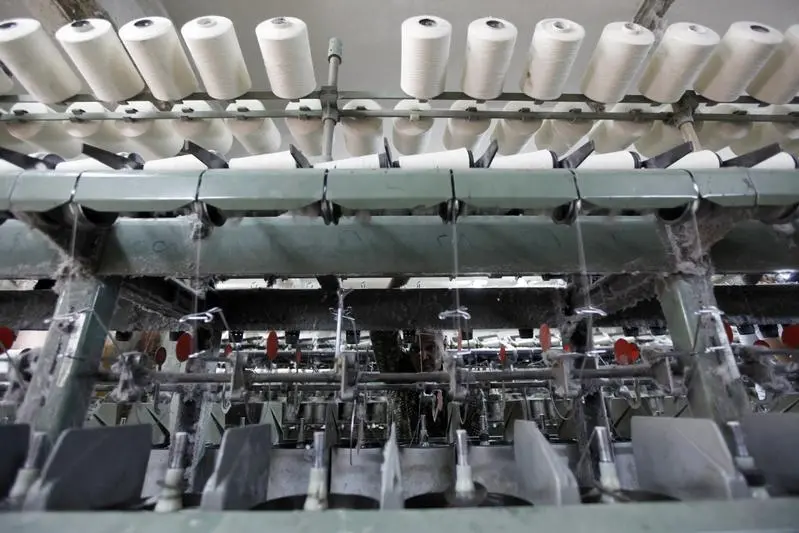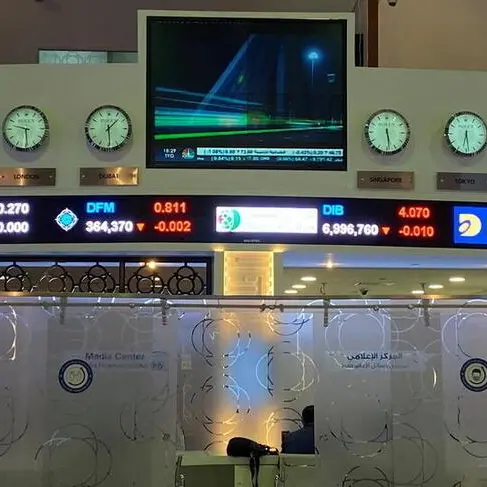PHOTO
Egyptian textile exports tripled in value in the years leading up to the 2011 revolution. With its natural advantages of geography and a cheap workforce, the local industry should be booming once again, thanks to the weak pound. Why isn't it?
George Saad used to work as a tour guide, introducing Italian and English-speaking visitors to Egypt's ancient Pharaonic wonders and breathtaking Red Sea resorts. But as tourism evaporated after the 2011 revolution, Saad, like so many others, was forced to close up shop. Now he works as a compliance manager at the Swiss Garments' factory in 10 Ramadan City, which is home to a number of local textile manufacturers. Swiss Garments, which makes men's suits for export to major international chains like the Gap and Zara, employs around 2,000 people. Saad, 28, confesses that he misses roving about the country with groups of curious foreigners, but in the current climate, he knows he's lucky to have a job. "Work is getting harder to find in Egypt," he says, "and the wages are getting smaller."
Before 2011, Swiss Garments' parent company, Arafa Holding--one of the country's largest clothing manufacturers--was riding a comfortable boom in Egyptian textile exports. Arafa, which specializes in menswear, was filling orders for Macy's, Pal Zileri and British Home Stores, among others. Egypt's textile exports reached almost $3 billion in 2011, up from around $1 billion in 2005, according to the United Nations Conference on Trade and Development, with ready-made garments for the European and American markets. "Buyers kept coming from the United States and Europe," says Arafa's managing director, Hala Hashem. "There was a lot of interest in Egypt."
In the years since, however, the industry has stalled in the wake of the economic slump that followed the January 25 uprising. Textile exports have mostly stayed flat in the last few years--in 2015, they slid 8.5 percent from the previous year to $2.7 billion, according to the trade ministry. This is notable given the dramatic devaluation of the Egyptian pound, which has lost 35 percent of its official value since 2011. Exports are supposed to benefit from a declining currency, according to classic economic theory, because their cost goes down for buyers abroad.
While Egypt has never gotten close to East Asian clothing-export giants like China and Bangladesh, the textile industry remains key to the local economy. The industry employs around 1.2 million people, accounting for 30 percent of industrial employment. With manufactured exports down across the board, clothes and textiles currently account for some 13 percent of Egypt's exports--making them its largest non-oil category. Egypt badly needs to bolster exports and foreign investment to solve a worsening hard-currency shortage and spiraling inflation, but industry insiders say that textile exports have remained a mixed picture due to a variety of economic and policy factors.
Even as the political situation became relatively stable again in recent years, overseas textile buyers have been scared off by unpredictable government policies and a generally unfriendly business environment. Moreover, the fact that Egyptian textile factories, like other industries, import a high percentage of their materials has cost businesses, as dollars are more and more expensive and in short supply. After 2011, major American chains including Macy's and J.C. Penney--which had both opened offices in Egypt to facilitate their business--pulled out, according to Hashem. "Buyers stopped coming to Egypt," she says.
"Security is an overriding concern," says Orestes Vasquez, a senior attaché with the United States Department of Agriculture's foreign service. Isolated incidents involving tourist fatalities haven't helped Egypt rebuild its reputation as a safe, stable place to do business. "People are scared, and it's hurting Egypt big time," says Vasquez. The country had yet to build its reputation as a major global textile exporter, so it was easier for foreign buyers to write Egypt off after 2011. "If it was a Vietnam or a Bangladesh then people would still be saying 'We need to get down there,'" he says.
Meanwhile, rising fuel prices and a chronic natural gas shortage has hurt industry in general. Mohamed Kassem, chairman of the Ready-made Garments Export Council of Egypt, estimates that some 1,400 textile factories have shut their doors in the last five years.
Large companies like Arafa were better able to stay afloat. Even in the current climate, the companies says it holds 15 percent of the formal-menswear market in the United Kingdom and 10 percent of Egypt's garment exports. The Swiss Garments factory in 10 Ramadan City buses men and women in daily from around Greater Cairo and the Delta, some of whom leave their houses before dawn to start the work day at 7:30 a.m. On a recent morning, workers were busy using buzz saws and laser machines to cut out puzzle-piece shapes of wool and cotton to be stitched together by other employees operating sewing machines. The suit jackets and trousers are passed down the assembly line to be inspected and affixed with price-tags featuring an already attached "discount" of £80.
In order to keep its foreign buyers, the company has cut prices and increased production to make its exports more competitive. "We used to make 2,400 suits a day," says Swiss Garments managing director Bassel Abdelrazzak Ahmed. "Now we produce 2,700." He goes on to explain that "on some orders we make no profit at all. We do it just to keep the client."
The almighty dollar
Kassem, of the Ready-made Garments Export Council, blames Egypt's controversial policy of holding the pound relatively steady against the dollar for the fact that textile exports have failed to profit from the cheap local currency. Officially, the pound has dropped from LE 5.79 in 2010 to LE 8.88 as of late July. In reality, however, almost nobody can get their hands on dollars at that rate, and the Central Bank has imposed strict controls on the purchase and transfer of hard currency. So companies that need dollars to import supplies in order to stay in business turn to black market forex dealers.
Late last month, the pound hit a record low of nearly LE 13 to the dollar on the parallel market--around 46 percent weaker than the official exchange rate--as speculation swirled regarding a further devaluation and firms feverishly tried to get their hands on greenbacks after Central Bank Governor Tarek Amer said publicly in early July that propping up the pound had been a mistake. Facing dwindling foreign reserves and pressure from the business community, the CBE has reluctantly undertaken a series of limited devaluations--the latest of around 14 percent taking place in March, briefly closing the gap with the black market. But the pound has since weakened to record lows on the black market, increasing pressure on the Central Bank to devalue further.
"As exporters, we don't really take advantage of the reduced currency," says Kassem. A major problem is that the official rate does not reflect the pound's real value. "When you keep your currency higher than it should be, you're hurting exports," says Kassem. "Look at the rest of the world, look at China. They keep their currency low to boost exports." Hala Hashem agrees: "The right thing to do is devalue."
At the same time, over the last five years, manufacturing costs have increased. Energy expenses have skyrocketed and living costs are at record highs. Legally obliged to increase wages by 7 percent each year, Hala Hashem points out that labor accounts for nearly a third of Arafa's overhead.
Meanwhile, imports have gotten more expensive due to the falling pound, and most manufacturers in Egypt rely heavily on imported materials. According to Shady Amin, the executive director of the National Council of Textiles, an average of 80 percent of materials in the textile sector are foreign-made. The further the pound drops, "the higher our costs go," says Amin.
Egypt failed to develop enough feeder industries for the textile sector during the gravy days before 2011, say members of the textile industry. In general, while the ready-made garment sector expanded rapidly, they didn't invest those profits into building factories that could produce locally made supplies of the goods on which they rely. "We're paying the price," says Magdi Tolba, CEO of Cairo Cotton Center, a firm that makes ready-made separates, largely for export. "We didn't invest properly, and now we are relying on imports." Hashem, of Arafa, agrees: "We started investing, but we did it too late."
Of the local companies that do make products that the ready-made garment sector needs--spinners, weavers, dyers etc.--around 60 percent are state-owned, according to Kassem, and are not managed efficiently. "They have large numbers of employees that they can't get rid of," says Vasquez of the USDA, "and very high absenteeism." Amin points out that many of these firms are incurring "huge losses." He adds: "They don't invest in personnel and their machines are obsolete," a major problem in an industry that depends on keeping equipment up-to-date in order to remain competitive.
With its close proximity to Europe, Asia and Africa, Egypt enjoys a natural geographical advantage in the export of manufactured goods. Moreover, wages are still relatively low. Arafa Holding, for example, pays its factory workers the equivalent of around $120 to $140 a month, including health benefits and social insurance. By way of comparison, textile workers in South Africa, which is currently the third-biggest economy on the continent after Nigeria and Egypt, take home $200 to $270 a month, according to the South African Clothing and Textile Workers' Union. Numbering nearly 60 million, Egypt's workforce is the largest in the MENA region, with high levels of unemployment. As a labor-intensive industry, one which employs a relatively large proportion of women, textile and clothing manufacturing has obvious benefits for a country struggling to right its economy. As long as industry growth is stalled, Egypt cannot capitalize on these advantages. "We are neither controlling population growth nor utilizing it," says Hashem.
Hanging by a thread
The boom of the pre-revolution years in Egypt's textile industry was helped by two important trade deals. The Egypt-EU Partnership Agreement, which came into effect in 2004, liberalized trade between Egypt and Europe. Meanwhile, the Qualifying Industrial Zones agreement was signed in 2005, which gave Egyptian products made in QIZ zones duty-free access to the United States market in exchange for using a certain percentage of inputs from Israel.
These deals were part of what Kassem describes as a "revolution" in government policy towards the textile industry. Efforts were made to reduce taxation for exporters, consolidating the previous progressive tax into a flat corporate rate. The Mubarak government launched "one-stop shops" in an effort to reduce red-tape, and export councils were set up to support industry. The Textile Export Council describes itself as "a public-private partnership organization working under the umbrella of the Ministry of Trade and Industry to promote Egyptian textile industries internationally." But industry insiders say many of these reforms didn't go far enough and the ones that were put in place have since been eroded.
Tolba, of Cairo Cotton, points out that there are actually three separate textile export councils--one for fabric, one for readymade garments and one for home textiles (carpets, curtains, etc.)--rather than enabling an efficient single body that could represent the needs of the industry as a whole. "I was always against this, we should have just one representative," he says.
Various capital controls imposed by the Central Bank since 2015 have limited the number of dollars leaving the country and capped foreign currency deposits at banks. But these attempts to shore up Egypt's hard currency reserves and stamp out the black market have taken a toll on local businesses that need dollars for crucial imports. Earlier this year, in response to the widespread outcry in the private sector, the CBE relaxed the deposit limits--removing a daily $10,000 limit and lifting monthly limits entirely for staple importers. Still, experts say the currency controls "wrought havoc in an already beleaguered industry," according to a March report by the USDA's Foreign Agricultural Service in Cairo. Meanwhile, the gap between the official and black market exchange rates has continued to widen, scaring off crucial foreign investment that analysts agree is the only long-term solution to Egypt's dollar shortage. "No foreign business wants to work like that," says Amin of the National Council of Textiles.
Meanwhile, a series of policy shifts connected to Egypt's failing cotton industry has also hurt textiles. Egypt's most iconic agricultural export has long been on the decline, with cotton production dropping from 2.5 million bales annually in the late 1970s to 970,000 in fiscal 2006/07. An all-time low of 320,000 bales was recorded in 2015/16, while a series of flip-flops by the government have fed questions about the very survival of the Egyptian cotton industry. In early 2015, the state announced that it was ending its longstanding policy of subsidizing cotton farmers, directing them to negotiate a price directly with producers instead. A few months later, in a move that seemed to be aimed at compensating for the damage wrought by canceling subsidies, the agriculture ministry announced that it was banning imported cotton, forcing textile manufacturers to buy local. In reality, it simply shifted the cost of subsidies onto the textile industry.
That's because nearly all local textile factories use the cheaper short- and medium-staple types of cotton used to produce mass market garments, and it isn't grown here. Egypt is known for its long-staple cotton that goes into high thread-count sheets and other luxury textiles. But processing this long-staple cotton properly requires state-of-the-art machinery the country lacks.
The government reversed its ban on imported cotton a week later, in the wake of a predictable outcry among textile factories. "All of us, even the minister of industry, were taken by surprise," Mohamed Eshra, vice president of the textile firm Eshratex, told Mada Masr, adding that other ministries had been surprised by the ban. Even local factories that use long-staple cotton tend to prefer U.S.-grown Pima cotton. "It was a very stupid move," says Kassem.
Other protectionist measures that restrict imports have stayed in place, however. Last August, Egypt imposed stricter standards for imported cotton. Importers must apply for a permit at least a month in advance, and the cotton must be free of whole or broken seeds when it arrives in the country, or it's sent back. Egypt is the only nation that requires cotton to be fumigated twice for pests--once at the country of origin and again at arrival--a measure the USDA estimates will cost the industry an extra $3 million to $5.5 million this year.
These policies are not standard global practice, and many believe they are not only ineffective but also counterproductive, costing Egypt badly needed growth. "They distort the whole supply chain," says Kassem.
Also true to form, Egypt has a textile megaproject in the pipeline. In May of this year, officials announced the signing of a "framework agreement" between the Egyptian Textile Industries Council and the China National Textile and Apparel Council to build a 1.2-square-meter "textile city" just south of the Upper-Egyptian city of Minya. Trade minister Tarek Kabil touted the move as an important step in establishing Egypt as a regional textile leader. No other details have been released.
The project has spurred familiar skepticism among industry members who say the emphasis should be on solving the problems of existing textile firms rather than building new ones. "The government is always talking about future projects," says Tolba, "but what about the investments we've already made?"
© Business Monthly 2016












